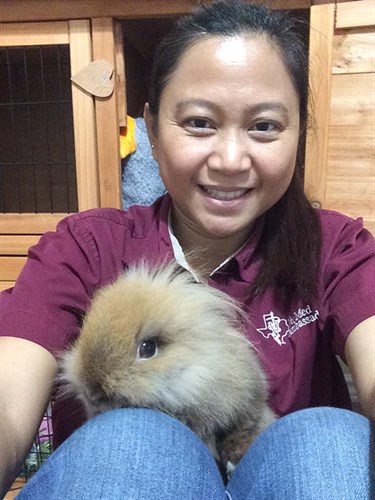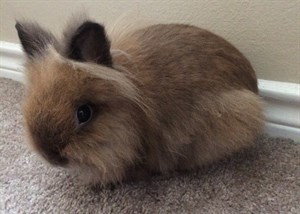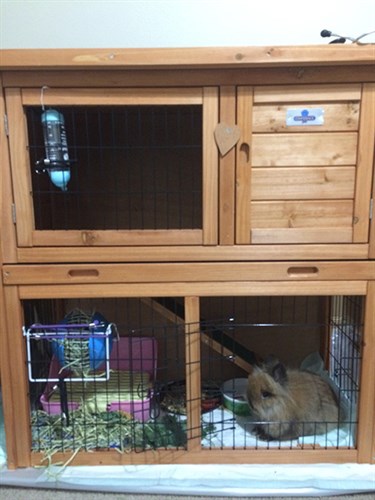
Yes! It’s a typical thing veterinary students do,” I whisper to myself.
This is a story of the Lionhead and me. It starts one Saturday morning when I am attending the Rat and Rabbit Wet lab, hosted by the Dental Club. The objective of this wet lab is for veterinary students to get hands-on experience with dental care for rats and rabbits. The rabbit breeder brought various breeds of rabbits, big and small, so students can learn to evaluate rabbit teeth. All rabbits are cute, but my eyes stopped at one small rabbit, one with a wool mane encircling the head, which makes it look like a little lion! I had never seen this breed before. Then, the breeder announced that she is currently trying to find a new home for one of her rabbits, and she pointed to that little Lionhead. And…that is the beginning of my life with little Lionhead.
Lionhead is the name of the rabbit breed. The Lionhead rabbit is unique because of its mane, which looks like the mane of a lion. This breed is popular in Europe and is a relatively new breed in the United States. The first Lionhead rabbit was imported to the United States in 2002. The American Rabbit Breeders Association approved the Lionhead Rabbit as an officially recognized breed in 2014.
Before the Lionhead, I had never had a rabbit as a pet. Luckily, as a veterinary student, I have had my fellow vet students and my professors to help guide me through rabbit husbandry, which has made becoming a “first-time rabbit mom” an easy transition. I named him “Joujou Nibble” due to the malocclusion (the misalignment or incorrect relation between the teeth of the two dental arches when they approach each other as the jaws close) of his upper incisor teeth.
Here are some of the first things I learned as a rabbit mom:
 Lesson No. 1 for a rabbit owner is to learn to check the rabbit teeth regularly, because rabbit teeth never stop growing. Therefore, it is easier to get malocclusion, especially when a rabbit does not get the appropriate diet (hay, pellet food, or vegetables). Joujou Nibble goes to the Zoo and Exotic service at the Texas A&M Small Animal Teaching Hospital to get his teeth trimmed. When I first got him, the Zoo and Exotic service kept Joujou Nibble for a couple days while I got his hutch, timothy hay, oat hay, pellets food, bedding, hay rack, toys, litter box, and rabbit igloo (because rabbits like to hide). It was fun to get my house ready for the rabbit.
Lesson No. 1 for a rabbit owner is to learn to check the rabbit teeth regularly, because rabbit teeth never stop growing. Therefore, it is easier to get malocclusion, especially when a rabbit does not get the appropriate diet (hay, pellet food, or vegetables). Joujou Nibble goes to the Zoo and Exotic service at the Texas A&M Small Animal Teaching Hospital to get his teeth trimmed. When I first got him, the Zoo and Exotic service kept Joujou Nibble for a couple days while I got his hutch, timothy hay, oat hay, pellets food, bedding, hay rack, toys, litter box, and rabbit igloo (because rabbits like to hide). It was fun to get my house ready for the rabbit.
Lesson No. 2—if the rabbits do not poop or eat or drink in 24 hours, it needs medical attention immediately. Because Joujou Nibble was stressed from changing his home and getting his teeth trimmed, he did not eat or drink or poop and I had to take him back to see the veterinarian at the Zoo and Exotic service again. At the teaching hospital, the veterinarian and vet tech taught me to evaluate the degree of dehydration and give IV fluid, to listen to his gut sound, and to critical care feed a rabbit with a syringe.

Lesson No. 3—rabbits sleep mostly during the day and sleep with their eyes open. At night, Joujou is awake. I can hear him chewing his pellet food or running up and down in his hutch.
Lesson No. 4—litter box training a rabbit is challenging. The veterinarian recommends filling his litter box with rabbit litter and topping it with hay, since rabbits like to eliminate in one corner of the box and munch the clean hay. I have not been very successful in getting him use his litter box, but at least now I know which corner is his favorite inside the pen.
Lesson No. 5—do not yell or punish the rabbit for having “accidents” outside of the litter box. I gently patted him when he did not use his litter box, and that is a mistake! I learned my lesson; Joujou Nibble disapproves that, stomping his back legs when I got closer to him. This can mean “look out,” “pay attention to me,” or “I’m really angry.” I now know his stomp means “I’m angry at you.”
As time has gone on, I’ve begun holding him and talking to him everyday. He is finally willing to come to me and sniff my hand, which is a “yay” moment to me. It feels like when a baby says “mama” for the first time. Bonding with my rabbit is rewarding. As a rabbit’s mom and a future veterinarian, raising my rabbit gives me an understanding of the rabbit behaviors, signs of illness, and how to do physical examinations.
Joujou Nibble and I still have many more lessons to learn about each other, but I am enjoying every moment of learning new things about him; that is how my life with the Lionhead goes.
